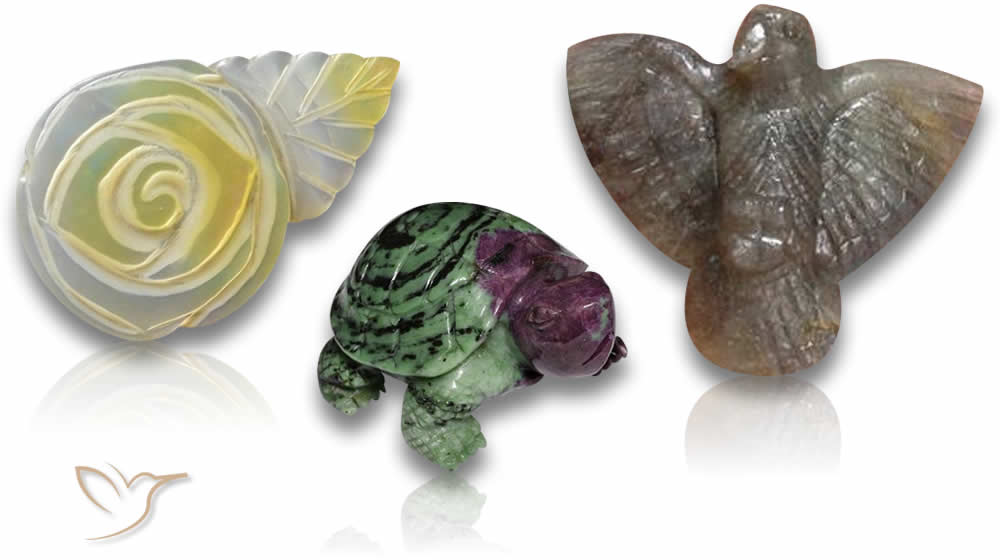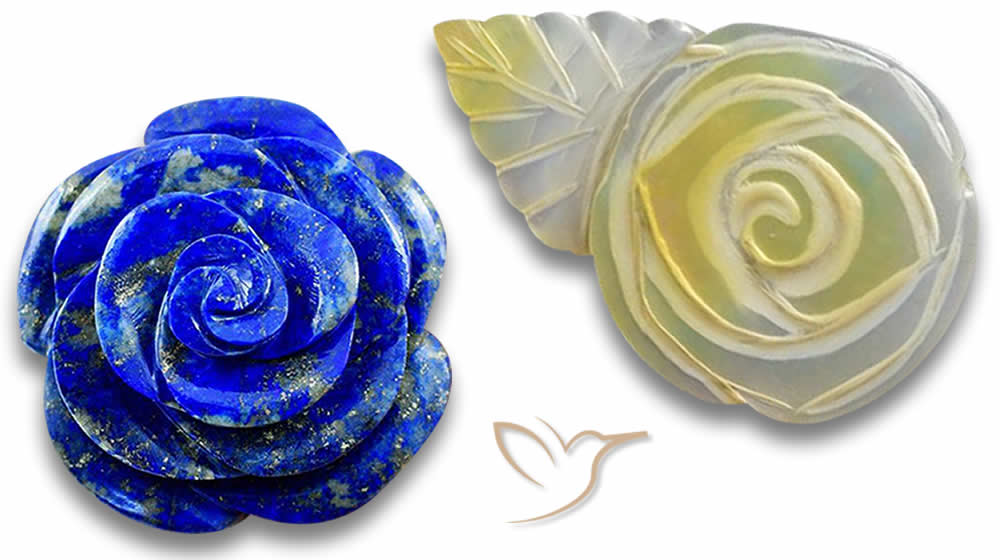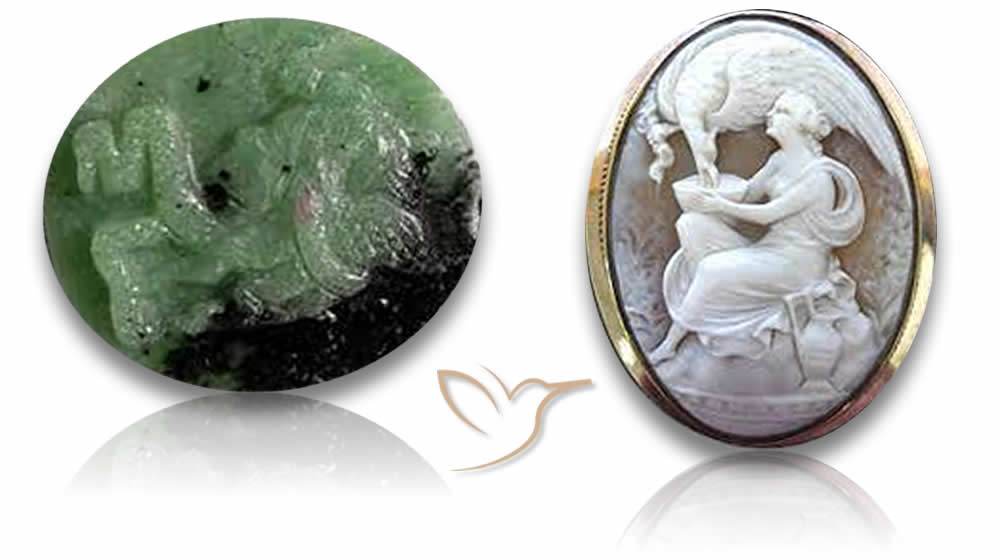Gemstone Carvings and Engravings: Artistic Decor

At the intersection of art and luxury lie gemstone carvings and engravings. These mesmerizing creations transform raw gemstones into exquisitely detailed gem carvings, each piece a testament to skilled craftsmanship. Few home decor options can match the elegance of carved gemstones, with each work boasting its own unique charm and character.
In this article, we will explore the captivating world of gemstone carvings and engravings, examining how these stunning gem carvings can elevate your home decor with their one-of-a-kind artistry. Whether you are an experienced collector or new to the world of gemstone art, we will provide an in-depth look at the beauty and craftsmanship behind these extraordinary creations.
Key Takeaways:
- Gemstone carvings and engravings are works of art that transform raw gems into mesmerizing masterpieces.
- These intricately crafted pieces boast a life of their own, enhancing your home decor with their unique beauty and splendor.
- Whether you are a collector or a newcomer, this article provides all the details you need to appreciate the beauty of gemstone carvings and engravings.
- Gemstone carving and engraving services offer a range of options for custom work and personalized pieces.
- Gemstone carving classes and essential supplies are available for those interested in learning the meticulous craftsmanship of this art form.
The Beauty of Gemstone Carvings and Engravings
Gemstone carvings and engravings are breathtaking works of art that showcase the natural beauty of gemstones in intricate details. Whether it's a two-inch figurine or a massive sculpture, the craftsmanship involved in creating these pieces is what makes them truly unique.
Through the careful use of chisels, saws, and other tools, artisans can bring out the best in these gemstones, creating mesmerizing patterns and shapes that speak to each piece's individuality. With gemstone carvings, it's all about the details and the craftsmanship that goes into each piece.

Gemstone engravings, on the other hand, are more about showcasing the natural colors and patterns of the gemstone itself. With techniques like intaglio and relief, artisans can create intricate and detailed designs on the gemstone's surface, making them truly one-of-a-kind pieces.
"Gemstone carvings and engravings are truly some of the most awe-inspiring works of art out there. They're so unique and intricate, and it's amazing to think of the time and effort that goes into creating each piece."
- Gemstone Enthusiast
Whether you're a collector or simply looking for a beautiful piece of home decor, gemstone carvings and engravings are sure to turn heads and add character to any space. Their natural attraction and the artistry involved in their creation make them a must-have for anyone who appreciates skillfully crafted works of art.
The Artisan Craftsmanship Behind Gemstone Carvings
At the heart of every stunning gemstone sculpture and intricate design lies the meticulous artisan craftsmanship that brings it to life. From raw gemstones to stunning works of art, skilled artisans use a variety of tools and techniques to transform each unique piece into a masterpiece.
Gemstone carving tools are an essential part of the artisan's toolkit. These tools include chisels, drills, saws, and polishing instruments, each with a specific purpose in the carving process. Skilled artisans carefully select the appropriate tool for each stage of the carving process, ensuring that they achieve the desired design while preserving the inherent beauty of the gemstone.
Gemstone sculptures are a popular form of gemstone carving, often depicting animals, plants, or other natural forms. By expertly carving and polishing the stone, artisans can bring these forms to life, creating three-dimensional works of art that capture the essence of their subject.
Gemstone carving designs range from simple to elaborate, often incorporating intricate patterns and details that require precision and skill. Artisans may use a variety of techniques, such as relief carving, intaglio carving, or cameo carving, to achieve their desired effect. Each gemstone carving design is unique, reflecting the artist's creativity and expertise in the field.
In summary, the artisan craftsmanship behind gemstone carvings is a testament to the beauty and allure of these exquisite works of art. Using gemstone carving tools and techniques, skilled artisans transform raw gemstones into stunning sculptures and intricate designs that capture the natural beauty of the stones.
Learning the Art of Gemstone Carving
Are you interested in creating your own unique gemstone carvings? You can learn the art of gemstone carving through classes offered by skilled artisans.
Gemstone carving classes provide a hands-on learning experience that is both informative and enjoyable. You'll learn the essential techniques involved in transforming raw gemstones into beautiful works of art. Instructors will guide you through the process, ensuring that you have the necessary knowledge and skills to create your own gemstone carvings.
When embarking on a gemstone carving journey, it's important to have the proper supplies at hand. Gemstone carving supplies include chisels, hammers, polishing tools, and a range of other equipment necessary for carving and shaping gemstones. It's essential to choose high-quality supplies to ensure that your creations are of the highest caliber.
Taking Gemstone Carving Classes: What to Expect
Gemstone carving classes typically cover topics such as:
- Introduction to gemstone carving tools
- Selecting and working with gemstones
- Carving and shaping techniques
- Polishing and finishing techniques
Classes are usually offered in a variety of formats, from one-day workshops to multi-week programs. Some classes may focus on specific types of gemstones or projects, such as carving intricate cameos or creating gemstone jewelry. No matter your interest or skill level, there are gemstone carving classes available to suit your needs.
Learning the art of gemstone carving is a rewarding and enjoyable experience. Not only will you gain a new skill, but you'll also create unique and beautiful works of art to display in your home or give as gifts.

Mastering Gemstone Engraving Techniques
Gemstone engraving is a fascinating art that requires precision, patience, and a keen eye for detail. There are various techniques used to etch intricate designs onto gemstones, including:
- Diamond-tipped engraving: This method uses a diamond-tipped tool to carve designs onto the gemstone's surface. It offers the most precise and detailed results but requires a steady hand and experience to avoid damaging the stone.
- Rotary engraving: A rotating bit is used to carve designs onto the gemstone, producing a shallow cut. This technique is perfect for creating patterns, textures, and visual interest.
- Laser engraving: Laser technology is used to etch precise designs onto the gemstone's surface without damaging the stone. The results are highly detailed and incredibly accurate.
To achieve the best results, gemstone engravers use a range of specialized tools, including:
- Burin: A hand-held tool with a sharp, chisel-like tip used for carving fine lines and intricate patterns.
- Micro-motor: A motorized tool used for rotary engraving that offers precision control and variable speed.
- Loupes: Magnifying glasses that provide close-up precision and enable engravers to see the fine details of their work.
Mastering these gemstone engraving techniques requires practice, and aspiring engravers can take classes or workshops to hone their skills. However, even experienced engravers often say that each gemstone is unique and presents new challenges requiring them to adapt their techniques to suit the stone's specific properties.
Conclusion
In conclusion, we hope that this article has shed light on the captivating world of gemstone carvings and engravings. We have explored the inherent beauty and allure of these exquisite pieces of art, as well as the meticulous craftsmanship and techniques involved in their creation. Additionally, we have touched upon the option of commissioning custom gemstone carvings and engravings, and the opportunity to learn the art of gemstone carving.
Whether you are an art aficionado or simply appreciate the beauty of natural gemstones, we encourage you to explore the world of gemstone carvings and engravings. These unique pieces can enhance your home decor, adding a touch of elegance and sophistication to any room.
Thank you for joining us on this journey. We hope to continue to educate and inspire you with our future articles.
FAQ
What are gemstone carvings and engravings?
Gemstone carvings and engravings refer to the art of transforming raw gemstones into intricate sculptures and designs. Skilled artisans use various tools and techniques to create detailed carvings and engravings on gemstones, showcasing their natural characteristics and colors.
What tools are used for gemstone carving?
Gemstone carving requires specialized tools such as chisels, files, and drills, which are specifically designed to work with different types of gemstones. These tools help artisans shape and refine the gemstone, bringing out its inherent beauty and creating stunning sculptures.
How are gemstone engravings created?
Gemstone engravings are created using techniques such as diamond point engraving, sandblasting, or laser engraving. These methods allow artisans to etch intricate designs onto the surface of the gemstone, adding a personalized touch and enhancing its aesthetic appeal.
What can gemstone carvings and engravings be used for?
Gemstone carvings and engravings serve as exquisite decorative pieces for your home or office. They can be displayed as standalone sculptures, incorporated into jewelry designs, or used as statement pieces in various decorative settings.
Can I request custom gemstone carvings and engravings?
Yes, many skilled artisans offer custom gemstone carving and engraving services. You can collaborate with them to create unique and personalized pieces based on your preferences, ensuring that you have a one-of-a-kind work of art that reflects your individual style.
Are there classes available to learn gemstone carving?
Yes, there are gemstone carving classes available for those interested in learning this art form. These classes provide hands-on guidance, teaching you the techniques and skills necessary to create your own gemstone carvings. Additionally, you can also find instructional resources and tutorials online to further enhance your knowledge.
Where can I find gemstone carving supplies?
Gemstone carving supplies, such as carving tools, gemstones, and polishing materials, can be found at specialized gemstone supply stores or online retailers. These supplies are essential for beginners and experienced carvers alike, enabling you to embark on your gemstone carving journey.
What are the key techniques used for gemstone engraving?
Gemstone engraving techniques include diamond point engraving, where a diamond-tipped tool is used to create detailed designs; sandblasting, which involves propelling abrasive materials onto the gemstone's surface to create patterns; and laser engraving, which utilizes lasers to etch precise and intricate designs onto the gemstone.

